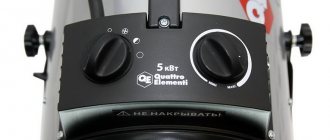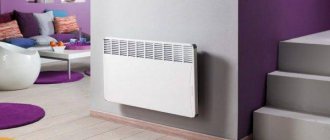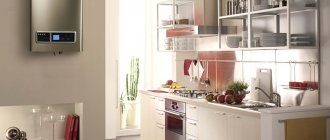For most car enthusiasts, as cold weather approaches, the question arises of how to heat the garage. One of the ways to achieve a comfortable temperature is heat guns, essentially powerful fan heaters. A heat gun consists of a heating element and a fan. Thanks to the cylindrical shape of the housing, the air passing through the heating element reaches a high temperature, and a powerful fan allows you to heat the air in the room in a short time.
Heat guns got their name because of their shape. Made in the form of a pipe mounted on a wheeled platform, they resemble cannons from Tsarist times. The presence of small wheels makes it easy to move these heating devices from one room to another.
How to choose the right heat gun for your garage?
First of all, you need to calculate the power of the heater. User experience suggests that to heat 25 cubic meters of garage, 1.5 kilowatts of gun power is needed, despite the fact that the temperature “overboard” will be about zero degrees. If the temperature reaches 10 - 15 degrees below zero, then two or even three times more power will be required.
Having correctly calculated the power of the heater, we select a suitable heat gun for the garage
To understand which heater is best for your garage, you need to know:
- how many resources the device will consume, and their cost;
- how long will people work with the warm device on;
- how fireproof this unit is;
- Is the garage insulated, and how well?
How to determine the required power of a heat gun
This is the most important and difficult point when choosing a heat gun. It is necessary to determine how much power will be enough to maintain a comfortable temperature in the garage at a given outside temperature.
To do this, you can use a simple ratio: 0.8−1.4 kW of thermal power per 10 m2 of garage area (with a ceiling height of 2.5 m). That is, for an average garage it is enough to take a gun with a power of up to 3 kW (and if you need a reserve in case of severe frosts - up to 5 kW), and a comfortable temperature will be ensured in it. However, powerful heat guns create significant stress on the wiring, which can lead to trouble.
Heat guns for garages of different capacities
For a more accurate calculation, you can use a simple formula:
Q = Vxt1-t2xkx0.1 163
Where V is the volume of the room, t1 is the required temperature in the room, t2 is the outside air temperature, k is the thermal insulation coefficient of the walls of the room. Multiplying by 0.1 163 is necessary to obtain a numerical value expressed in kW (since the formula derives the amount of heat expressed in calories, and 1 kW/h is equal to 860 kcal/h).
Thermal insulation coefficients for various materials have been derived experimentally, and they are approximately as follows:
— Garage made of simple wooden boards or metal — k=3...4; — Brickwork in one row with thermal insulation of medium thickness — k=2...2.9; — Brickwork in two rows with good thermal insulation — k=1…1.9; — High-quality thermal insulation of walls and roof — k=0.6...0.9.
This way you can calculate the required heat output of the gun for any type of room. However, as already mentioned, for garages you can use guns at a rate of up to 1.4 kW per 10 m2 of area, and in most cases this will be more than enough.
Rating of popular models
Today there is a wide range of gas guns on the market. From budget models for home use. To equipment from well-known brands, with advanced functionality for professional work. When choosing a model, you should pay more attention to safety. Equipment equipped with sensors, thermostats and overheating protection is higher in price. But it’s not worth saving on them. It's better to pay attention to power.
Sibrtech GH-10
One of the budget gas guns from the Russian manufacturer of the same name. Designed for heating small production workshops, warehouses, greenhouses. And also for quickly drying walls and floors after plastering surfaces and installing screeds. A simple and reliable model, with a self-diagnosis system and protection against flame extinction, power outages or gas supply interruptions. Propane is used as fuel.
Sibrtech GH-10
Advantages:
- Compact, no more than 40 cm in length;
- The light weight of 5.5 kg and the ergonomic rubberized handle make it easy to move the gun and use it to heat seams, joints, trenches, and concrete;
- Economical gas consumption of 0.7 kg/hour and good power for a model in this price category. In an hour it warms up to 300 m3 of air;
- Well-developed protection system. The double housing protects against burns and turns off when overheated;
- Long service life.
Flaws:
- Low maneuverability due to short cord;
- No power regulation.
The average price of a Sibrtech GH-10 gas gun is 5,700-6,000 rubles.
Interskol TPG-10
An easy-to-use and highly efficient device developed at the Izhevsk State Technical University. M. T. Kalashnikova. The gas gun is similar in characteristics to the previous model. The advantage is higher air temperature – at least 90 degrees. They are used both for heating and for performing a number of technological works, which is facilitated by their low weight of 5.5 kg, compactness and maneuverability.
Interskol TPG-10
Advantages:
- Runs on propane and butane;
- Warms well;
- Low gas consumption – within 0.7-0.8 kg/h;
- High level of protection against flame extinction;
- The thermostat allows you to maintain the set temperature, which reduces fuel consumption;
- The galvanized body is protected from corrosion for a long time;
- During operation they do not emit soot.
Flaws:
- If there is a thermostat, there is no possibility of adjusting the temperature and power;
- There are complaints about the operation of the piezo ignition.
However, for a price of 6000-6500 rubles, the Interskol TPG-10 gas gun has good functionality.
BISON MASTER, TPG10000_M2
A universal gas gun with direct combustion and low fuel consumption. Suitable for heating industrial workshops or warehouses with an area of up to 100 m2. It is especially appreciated by suspended ceiling installers for its compactness, maneuverability and low weight of 5.3 kg.
BISON MASTER, TPG10000_M2
Advantages:
- Stable combustion in vertical and horizontal positions;
- Uniform and rapid heating of the entire room;
- The protective casing not only protects the case from overheating, but allows the equipment to be used in conditions of high humidity, when drying rooms;
- A protective system that automatically stops the gas supply when the flame goes out or the power goes out. There is also protection against overheating;
- The presence of a thermostat.
Flaws:
- There is no way to regulate temperature and power by air supply.
The average cost of the “ZUBR MASTER, TPG10000_M2” model is 5800-6000 rubles.
Resanta TGP-10000
Functional gas gun. Copes with heating of rooms up to 100 m2. Suitable for drying out premises after construction. Can be used for drying lumber and wood blanks. Lightweight, compact and mobile gas gun is ideal for heating greenhouses.
Resanta TGP-10000
Advantages:
- It has a good power reserve with low fuel consumption. On average, consumes up to 0.75 kg per hour;
- It is characterized by increased mobility due to its small size and weight of 6 kg;
- Works both on main propane/butane and on liquefied gas in a cylinder;
- Stable combustion;
- Ergonomic carrying handle;
- Automatic shutdown when the flame goes out.
Flaws:
- Lack of adjustment for air supply power and temperature.
The cost of a gas gun is about 6000-6200 rubles.
Hyundai H-HI1-10-UI580
A gas gun will be an excellent assistant, both in production or in agriculture, and at home. Its main advantage is functionality. It quickly heats the air even in large rooms and is suitable for quickly drying walls and ceilings during finishing work. Its small size and high power allow it to be used in greenhouses, as well as when performing construction or excavation work in winter.
Hyundai H-HI1-10-UI580
Advantages:
- Optimal ratio in terms of power, workmanship, durability and price;
- Copes well at temperatures down to 30 degrees below zero;
- Additional oxygen supply ensures stable combustion in a vertical position, or in an open space with strong gusty winds;
- Smooth adjustment of air supply;
- Automatic shutdown when the flame goes out, power outage, gas supply interruption;
- Stability and non-slip on any surface, thanks to rubberized legs with a wide base;
- Stylish design;
- Weight up to 5 kg;
- Compactness.
Flaws:
- Requires good ventilation, as it quickly burns out oxygen;
- It dries out the air greatly, which is especially noticeable in greenhouses.
The cost of the universal model is 5500-6000 rubles.
Master BLP 17 M
Lightweight, economical and at the same time powerful gas gun made in Italy. Its power is 16 kW. Most often it is used for heating production workshops and warehouses. Suitable for fast and efficient drying of materials. Widely used in construction to prepare interior spaces for rough and white finishing.
Master BLP 17 M
Advantages:
- Optimal power for universal use;
- Can heat an area of up to 200 m2;
- The presence of a protective grill allows you to work without fear that dirt or debris will get inside;
- Economical fuel consumption, which is propane-butane;
- Heat-resistant housing coating;
- Power and temperature adjustment;
- Several levels of protection against overheating and flame extinction;
- Can also be used for cooling rooms. It is enough to shut off the fuel supply.
Flaws:
- No automatic ignition.
There is only one drawback, but it is quite significant for a gas gun costing 9,800-10,000 rubles.
Aurora GAS HEAT 50
A gas gun from a Russian manufacturer working according to European standards ensures complete safety and durability of its use. Ideal for heating production workshops with an area of up to 300 m2. Heats up to 1500 m3 of air in one hour.
Aurora GAS HEAT 50
Advantages:
- Made from high strength stainless steel;
- Good thermal protection prevents the body from heating up during the production process;
- Several levels of protection against combustion products entering the atmosphere;
- High power level up to 50 kW, with low gas consumption;
- Can be used as a fan;
- Power adjustment;
- It is possible to change the nozzle angle;
- Full set upon delivery, including step-by-step instructions for installing and setting up the device in Russian.
Flaws:
- Mostly stationary equipment, weighing about 14 kg;
- Repair in service centers using original spare parts.
It is worth noting that the last point is not particularly relevant. “Aurora GAS HEAT 50” is a reliable device that will serve for many years. Cost – 11000-11500 rubles.
Types of heat guns
Electric heat guns
A heat gun, the main resource of which is electric current, is similar in principle to a regular hair dryer. The heating element, in most cases a heating element, and the dimensions of the device are slightly larger than those of a household hair dryer. An electric heat gun for a garage is powered by a standard single-phase network, but a gun with a power of five kilowatts or more is connected to a three-phase network. The device contains a temperature relay, which controls the device, turning it off if the temperature in the garage has reached the required level, and vice versa. Before purchasing this heater, you need to make sure that the electrical wiring in the garage can withstand the load consumed.
Electric heat gun
Pros of an electric gun:
- Relatively small device dimensions;
- Low noise level during operation;
- No open fire.
Disadvantages of this type of gun:
- High cost of electricity;
- The need for power or quality wiring in the garage.
Gas heat guns.
A gas heat gun, as the name suggests, runs on liquefied propane-butane gas. The use of such a heater requires the presence of a gas cylinder of any volume. The principle of operation is that a gas burner is installed inside the cylindrical tube of the gun, which ignites the gas and heats the air. A powerful fan allows you to distribute hot air throughout the garage as quickly as possible. These heaters have a piezo element for easy ignition. All gas guns are direct combustion heaters and do not have the ability to remove exhaust gases from the room. Although guns of this type consume gas economically and do not emit many combustion products, it is still necessary to take care of ventilation in the garage. For ventilation, you can ventilate the room from time to time, but in this case, heat will also leave the garage with exhaust gases.
Gas heat gun
Interesting: Operating at a power of 10-15 kilowatts, a gas heat gun will consume half a liter of gas in 60 minutes.
Advantages of gas heat guns:
- Economical gas consumption;
- Due to its low weight, it is easy to transport to other rooms;
- Compact dimensions allow you to place it anywhere;
- High performance, will help quickly heat the garage;
- Availability of a carbon dioxide concentration sensor.
Upsetting nuances of operation:
- A gas cylinder is required;
- High-quality ventilation is needed;
- Noise during operation;
- The presence of a flame does not allow you to leave the device unattended.
Features of using guns
Today, electric fan heaters of various types and devices are considered the most popular for quickly heating a garage, although the condition of the wiring leaves much to be desired. Therefore, fire inspectors like to visit such public places to draw up reports of various violations.
It is no secret that the indirect cause of all fires in garages is the improper use of heaters of various types, from homemade to factory-made models. As a rule, the fault here is 100% of the users: before connecting an electric gun of any power, you need to consult with energy network specialists. In addition, you must follow certain operating rules for products of any kind.
- After purchasing the equipment, you need to let it sit in a warm place for at least 2 hours.
- If this is a diesel version or a gas heat gun, purchased specifically for a pre-insulated garage, it is better to start them for the first time in the open air so that the factory lubricant burns.
- Before turning on the electric option, you must check for the presence of condensation on the heating elements, and also inspect the grounding of the garage wiring.
- A gun operating on waste oil is checked for the presence of foreign objects in the fuel tank before filling with fuel.
- When using a chimney, it must have good draft and a minimum of bends.
- When connecting a gas gun, check all connections for leaks, otherwise the first activation may be the last.
The device must be installed only on a flat surface, the distance from the outlet nozzle to walls or other objects is at least 3 m, 0.5 m on the sides is enough, and 1.5 m on top. Such precautions are necessary so that the flow of forced air spreads freely throughout room.
As for the cost: diesel devices are considered the most expensive: their price starts from $200, gas ones are in the middle position around $150, and electric options start from $50. Having made the right choice, you will forget about frozen hands and an engine that won’t start due to the cold for at least six months - working in the garage will be comfortable, even though there is severe frost outside the gate.
Diesel heat guns
The main fuel of diesel heat guns is diesel fuel, or diesel fuel. For the operation of this heater, it does not matter what quality of diesel fuel is used, so it is especially convenient for those who have access to cheap fuel. Working on diesel fuel requires a fuel tank, and this increases the weight of the unit. On average, a twenty-liter fuel tank lasts for 10 to 15 hours of operation, while the thermal power will be approximately 30 kilowatts. Diesel guns are essentially the most powerful compared to other types.
Diesel heat guns
Diesel heat guns are divided into two types: with direct and indirect heating.
- Direct combustion. The operating principle of a direct heating gun is similar to a gas heat gun. The fuel is supplied through a pump to the combustion chamber, where the air is heated and dispersed throughout the garage using a fan. Combustion products also remain in the room and require ventilation.
- Indirect combustion. In this case, diesel fuel also burns in the combustion chamber, only the chamber itself does not directly contact the environment, but transfers energy through a heat exchanger. A special exhaust pipe is provided to remove exhaust gases. Although the combustion process still requires oxygen, you will not have to ventilate the room as often.
Advantages of diesel heat guns:
- Low fuel consumption;
- Thermal efficiency 100%;
- Safety of use;
Disadvantages of these guns:
- For direct combustion guns, this is the release of exhaust gases into the garage;
- Units with indirect combustion cost twice as much;
- The presence of a chimney opening for guns with indirect combustion;
- High noise level;
- The weight of the device is about 20 kilograms;
Combined heat guns.
In order to be able to constantly work in the garage, you can combine guns. Initially, you can use a gas heat gun to heat the room, and use a diesel heat gun with indirect combustion to maintain the temperature. In this case, there is no need to constantly ventilate the garage, and at the same time maintain a comfortable temperature. However, this method has one big drawback - the cost of purchasing two guns.
Gas convectors
In addition to gas guns, gas convectors are excellent for heating a garage. During their operation, combustion products do not enter the room; the device can be used without human presence.
The operating principle of a gas convector is similar to a conventional cast iron radiator, with the difference that water does not flow inside it, but a fire burns.
Flue gases are removed and air is taken in using a coaxial chimney. Combustion products are removed through the inner pipe, and air is taken in through the outer pipe. The draft occurs due to the difference in the densities of the removed gases and the outside air.
There are also models with a conventional chimney, when combustion air is taken from the room.
Fuel combustion occurs in the combustion chamber using a burner. The burner is ignited by a piezoelectric element, which is powered by a battery. Electricity is not required to operate a gas convector. Due to combustion, the combustion chamber heats up and the air in the room around it heats up. To speed up and distribute heating evenly, some models have a fan installed.
Advantages:
- Possibility of operation without human presence
- Reliability
- Easy cold start and adjustment.
- Gas is a cheap fuel.
- Fast room heating
Flaws:
- It can only be placed near the outer wall (coaxial chimney).
- The need to install a chimney.
Recommendations for choosing a heat gun for a garage
Based on the above advantages and disadvantages, we can see the following. The use of electric guns is convenient and safe in the sense that they do not require additional conditions, such as a fuel tank or cylinder, a supply ventilation system or a chimney opening in the garage. However, the productivity of such heaters is quite low, and energy consumption is high. In addition, with a weak electrical circuit, it is unlikely that you will be able to do welding and heating at the same time. It's also not safe.
Gas heat guns are more productive, but the consequence of their operation is the presence of carbon monoxide in the garage. And since a garage is usually not a very large room, the concentration of carbon dioxide will be higher and it will be more tedious to ventilate the room. If this is not done, then a process of poisoning of the body occurs. Therefore, a gas heat gun is not the best option for heating a garage.
Diesel heat guns are “above all praise.” Although they have the largest dimensions of all guns, there is still room in the garage to install this unit. Of course, the high cost of an indirect combustion gun is its disadvantage, but productivity makes up for all the shortcomings. Such a gun allows you to safely heat the garage without harming the health of the owner. It is fireproof because the fuel, when ignited, does not come into contact with the environment. On it, like on any other gun, you still cannot dry things and gloves. It also requires 220V power to operate, but does not require a power line or high quality wiring. Electricity is needed to operate the fan, and any electrical network can handle its power consumption.
Video on the topic:
Other criteria influencing the choice
In addition to the technical parameters described above, before purchasing a gas gun, it is recommended to evaluate other criteria that will affect ease of use. These include:
- Noise level is an important factor when a heater is purchased for residential premises. The noise level acceptable for human perception should not exceed 35-40 dB. Otherwise, being in a building with a very loud fan will be uncomfortable.
- Security system - a durable metal body, a thermostat, a flame controller and a self-shutdown option will allow you not to worry about a possible fire even when the gas gun is unattended.
- Type of design - if the unit is purchased for buildings where centralized heating is not planned, then you should opt for a stationary model. A mobile heater is good as an alternative source of heat - it is easy to move and install in any convenient place, directing air flow in the desired direction.
- Ignition system - the manual ignition method is not always convenient, but is characterized by increased reliability. Piezo ignition is considered a more “advanced” mechanism - a spark is generated by simply pressing. But in some cases, the piezo may not work the first time, and high humidity can damage the element.
- Temperature control and thermostat - allow you to maintain a constant temperature in a heated location and adjust the operation of the device to individual needs, changing the values depending on weather conditions.
Analyzing the models and designs of gas heat guns, we can come to the conclusion that when choosing a suitable installation, you should focus on parameters such as type of heating (direct/indirect), fuel consumption and thermal power.
Consider the area of the heated room, pay attention to additional options that will make the process of using the devices comfortable and as safe as possible. Return to list of articles











